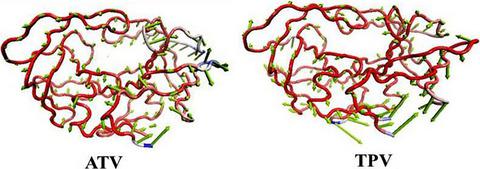当前位置:
X-MOL 学术
›
Chem. Bio. Drug Des.
›
论文详情
Our official English website, www.x-mol.net, welcomes your
feedback! (Note: you will need to create a separate account there.)
Exploring the flap dynamics of the South African HIV subtype C protease in presence of FDA‐approved inhibitors: MD study
Chemical Biology & Drug Design ( IF 3.2 ) Pub Date : 2018-09-24 , DOI: 10.1111/cbdd.13364 Siyabonga I. Maphumulo 1 , Amit K. Halder 1 , Thavendran Govender 1 , Sibusiso Maseko 1 , Glenn E. M. Maguire 1, 2 , Bahareh Honarparvar 1 , Hendrik G. Kruger 1
Chemical Biology & Drug Design ( IF 3.2 ) Pub Date : 2018-09-24 , DOI: 10.1111/cbdd.13364 Siyabonga I. Maphumulo 1 , Amit K. Halder 1 , Thavendran Govender 1 , Sibusiso Maseko 1 , Glenn E. M. Maguire 1, 2 , Bahareh Honarparvar 1 , Hendrik G. Kruger 1
Affiliation

|
HIV‐1 protease (HIV PR) is considered as one of the most attractive targets for the treatment of HIV and the impact of flap dynamics of HIV PR on the binding affinities of protease inhibitors (PIs) is a crucial ongoing research field. Recently, our research group evaluated the binding affinities of different FDA approved PIs against the South African HIV‐1 subtype C (C‐SA) protease (PR). The CSA‐HIV PR displayed weaker binding affinity for most of the clinical PIs compared to HIV‐1 B subtype for West and Central Europe, the Americas. In the current work, the flap dynamics of four different systems of HIV‐1 C‐SA PR complexed to FDA approved second generation PIs and its impact on binding was explored over the molecular dynamic trajectories. It was observed that the interactions of the selected drugs with the binding site residues of the protease may not be the major contributor for affinity towards PIs. Various post‐MD analyses were performed, also entropic contributions, solvation free energies and hydrophobic core formation interactions were studied to assess how the flap dynamics of C‐SA PR which is affected by such factors. From these contributions, large van der Waals interactions and low solvation free energies were found to be major factors for the higher activity of ATV against C‐SA HIV PR. Furthermore, a comparatively stable hydrophobic core may be responsible for higher stability of the PR flaps of the ATV complex. The outcome of this study provides significant guidance to how the flap dynamics of C‐SA PR is affected by various factors as a result of the binding affinity of various protease inhibitors. It will also assist with the design of potent inhibitors against C‐SA HIV PR that apart from binding in the active site of PR can interacts with the flaps to prevent opening of the flaps resulting in inactivation of the protease.
中文翻译:

在FDA批准的抑制剂存在下研究南非HIV C亚型蛋白酶的皮瓣动力学:MD研究
HIV-1蛋白酶(HIV PR)被认为是治疗HIV的最有吸引力的靶标之一,HIV PR的皮瓣动力学对蛋白酶抑制剂(PIs)结合亲和力的影响是一个至关重要的正在进行的研究领域。最近,我们的研究小组评估了不同的FDA批准的PI与南非HIV-1亚型C(C-SA)蛋白酶(PR)的结合亲和力。与西欧和中欧,美洲的HIV-1 B亚型相比,CSA-HIV PR对大多数临床PI的结合亲和力较弱。在当前的工作中,与FDA批准的第二代PI配合使用的四个不同HIV-1 C-SA PR系统的皮瓣动力学,并探讨了其对结合的影响,涉及分子动力学轨迹。观察到所选药物与蛋白酶结合位点残基的相互作用可能不是对PIs亲和力的主要贡献者。进行了各种MD后分析,还研究了熵贡献,溶剂化自由能和疏水核形成相互作用,以评估C-SA PR的襟翼动力学如何受到这些因素的影响。从这些贡献中,发现大范德华相互作用和低溶剂化自由能是导致ATV抵抗C-SA HIV PR活性更高的主要因素。此外,相对稳定的疏水核可能是造成ATV复合体PR瓣更高稳定性的原因。这项研究的结果为各种蛋白酶抑制剂的结合亲和力如何影响C‐SA PR的皮瓣动力学受到各种因素的影响提供了重要指导。它还可以帮助设计有效的C-SA HIV PR抑制剂,该抑制剂除了与PR的活性位点结合外,还可以与襟翼相互作用,以防止襟翼张开,从而导致蛋白酶失活。
更新日期:2018-09-24
中文翻译:

在FDA批准的抑制剂存在下研究南非HIV C亚型蛋白酶的皮瓣动力学:MD研究
HIV-1蛋白酶(HIV PR)被认为是治疗HIV的最有吸引力的靶标之一,HIV PR的皮瓣动力学对蛋白酶抑制剂(PIs)结合亲和力的影响是一个至关重要的正在进行的研究领域。最近,我们的研究小组评估了不同的FDA批准的PI与南非HIV-1亚型C(C-SA)蛋白酶(PR)的结合亲和力。与西欧和中欧,美洲的HIV-1 B亚型相比,CSA-HIV PR对大多数临床PI的结合亲和力较弱。在当前的工作中,与FDA批准的第二代PI配合使用的四个不同HIV-1 C-SA PR系统的皮瓣动力学,并探讨了其对结合的影响,涉及分子动力学轨迹。观察到所选药物与蛋白酶结合位点残基的相互作用可能不是对PIs亲和力的主要贡献者。进行了各种MD后分析,还研究了熵贡献,溶剂化自由能和疏水核形成相互作用,以评估C-SA PR的襟翼动力学如何受到这些因素的影响。从这些贡献中,发现大范德华相互作用和低溶剂化自由能是导致ATV抵抗C-SA HIV PR活性更高的主要因素。此外,相对稳定的疏水核可能是造成ATV复合体PR瓣更高稳定性的原因。这项研究的结果为各种蛋白酶抑制剂的结合亲和力如何影响C‐SA PR的皮瓣动力学受到各种因素的影响提供了重要指导。它还可以帮助设计有效的C-SA HIV PR抑制剂,该抑制剂除了与PR的活性位点结合外,还可以与襟翼相互作用,以防止襟翼张开,从而导致蛋白酶失活。











































 京公网安备 11010802027423号
京公网安备 11010802027423号